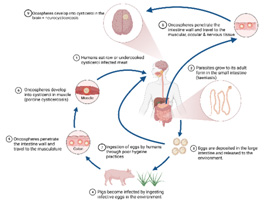Parasitic foodborne zoonoses are a serious public health challenge, leading to human health impacts though disease, economic losses due to our response to the parasite (condemnation or other mitigation action) and potential environmental impacts through post-harvest losses. Government-level decisions on which (if any) control strategies to adopt in an abattoir setting are made on the basis of several factors, including but not limited to the economic efficiency of the intervention.

Taenia solium is a zoonotic cestode predominately associated with LMICs where the key risk factors of free-ranging pig production, low sanitation coverage and high levels of poverty (associated with poor access to human and animal health care and inadequate meat hygiene services). Despite being rarely seen in European countries there is evidence that endemic areas still exist (Zammarchi et al., 2013, Fabiani & Bruschi 2013, Devleesschauwer et al., 2017, Laranjo-Gonzalez et al., 2017 and Del Brutto 2012). Although the most recent global endemicity map from the WHO considers Spain non-endemic for T. solium (Donadeu et al., 2022), Spain has reported clinical cases of human cysticercosis (Herrador et al., 2018). While it is hypothesized that high levels of inward migration drove the rise in cases seen up to 2008, some cases are potentially autochthonous and the 2019 EFSA zoonoses report indicates that Spain reported a 0.004% prevalence of cysticercosis in slaughter pigs (1,513/37,835,368).
Detection of T. solium at slaughter is covered through the minimum post-mortem inspection requirements (including visual inspection, palpation and some restricted incision) as laid out in Regulation (EC) No 854/2004 and the competent authority has the power to allocate low risk animals according to epidemiological data or those raised under controlled conditions since weaning, to visual only inspection. In line with Regulation EC No 854/2004 other incisions may be made in body parts deemed to be suspect. Animals with cysticercosis are considered unfit for human consumption, apart from non-generalised cases, which can be passed as fit after cold treatment. Directive 2003/99/EC on the monitoring of zoonoses and zoonotic agents indicates the requirement to report animal cases, though indications are that this is not always adhered to (Herrador et al., 2018). Harmonized guidelines for the monitoring and reporting of Cysticercus in animals and foodstuffs in the European Union have been produced by EFSA, but the lack of sensitive diagnostics has thus far hindered improvements in reporting and despite calls for Neurocysticercosis in humans to be made a reportable disease this has not yet been enacted (Herrador et al., 2018).
In this hypothetical scenario, it is 2025. The prevalence of porcine cysticercosis has risen to 1% and Spain has identified 200 cases of Neurocysticercosis which are thought to be of autochthonous. The Agencia Española de Seguridad Alimentaria y Nutrición has requested that you conduct an economic analysis to determine the benefits of adopting one of two different in-abattoir control strategies for T. solium. A) Mandating incisions in the masseters and increasing the incisions in the heart for all pigs other than those directed to visual only inspection based on epidemiological and holding data (EC 854/2004 Section IV, Chapter IV, B para 2) Subjecting all pigs other than those exempt in para 2 to cold treatment at -24°C for 24hrs (Frassen et al., 2019).
In the workshop I will be on hand whilst your group develops a presentation detailing your approach to such an analysis (don’t worry I’m not expecting you to give me an answer
In preparation for the workshop I recommend spending time reading the following resources and considering your answers to the above questions to bring to the group;
- Which economic evaluation framework(s) may be relevant to this task, which would you pick and why?
- What perspective(s) may be relevant to such an evaluation?
- What are the different costs and benefits you may consider in this evaluation, in what ways can these be measured and valued?
- What sources of data might you use?
- How would you present and interpret your analysis?
- Are there other alternative courses of action which could be considered?
- What other factors that you may not necessarily have captured in your analysis may also impact on the decision making process?
Some additional references can be found here (if you have any issues with links just email me on l.thomas@cgiar.org
Literature:
- Food Safety Economics
- Burden of Cysticercosis in Uganda
- Societal Cost-Benefit Analysis for Toxoplasma gondii
- Risk-Based inspection as a cost-effective strategy to reduce exposure to T. saginata
- Seminar on the economics of one health (excuse the technological glitches)
- Health Metrics for Helminth Infections
- Combining Risk Assessment of human health, food waste and energy consumption
- Life cycle assesments for pork in Spain (traditional intensive)
- Food safety and the environment
- Multi-criteria decision analysis for food safety
- Economic Issues in Food Safety
- Legal-Economic Perspective to managing food safety in the EU

